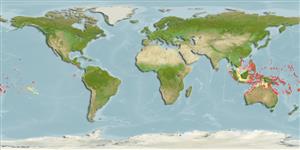Classification / Names
Common names from other countries
Main reference
Size / Weight / Age
Max length : 40.0 cm TL male/unsexed; (Ref. 48636)
Environment
Marine; reef-associated; depth range 2 - 40 m (Ref. 90102), usually 20 - ? m (Ref. 9710)
Climate / Range
Tropical, preferred ?; 19°N - 24°S
Distribution
Western Central Pacific: Philippines to the Solomon Islands, north to the Marshall Islands, south to Scott Reef and the Great Barrier Reef. Recently recorded from Tonga (Ref. 53797).
Countries | FAO areas | Ecosystems | Occurrences | Introductions
Short description
Dorsal
spines
(total): 9;
Dorsal
soft rays
(total): 10;
Anal
spines: 3;
Anal
soft rays: 9. Males recognized by the yellow pectoral fins, horizontal green band from tip of snout to above pectoral fin base and large individuals with oval yellow patch on caudal peduncle. Females plain yellowish grey with pale lines along abdominal area (Ref. 48636). Scales large. Median predorsal scales 4; 3 scale rows on cheek, ventral row with 1-2 scales. Truncate caudal fin in initial phase (slightly rounded); slightly lunate in terminal phase. Dental plates nearly covered by lips. Terminal males with 1 or 2 upward-projecting canines posteriorly on lower dental plate and 1 on upper plate. Large initial phase individuals are tan while terminal phase individuals have a distinctive transparent yellowish-tan pectoral fin (Ref. 1602).
IUCN Red List Status (Ref. 115185)
Threat to humans
Harmless
Human uses
Aquarium: commercial
More information
ReferencesAquacultureAquaculture profileStrainsGeneticsAllele frequenciesHeritabilityDiseasesProcessingMass conversion
Tools
Special reports
Download XML
Internet sources
Estimates of some properties based on models
Phylogenetic diversity index
PD50 = 0.5000 many relatives (e.g. carps) 0.5 - 2.0 few relatives (e.g. lungfishes)
Trophic Level
2.0 ±0.00 se; Based on food items.
Resilience
Medium, minimum population doubling time 1.4 - 4.4 years (Preliminary K or Fecundity.)
Vulnerability
Low to moderate vulnerability (30 of 100)
Price category
